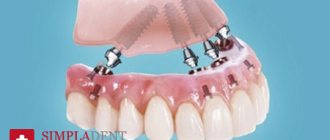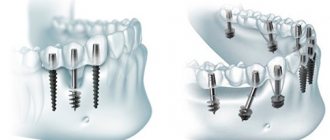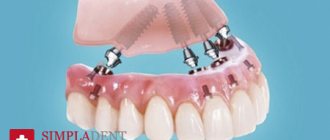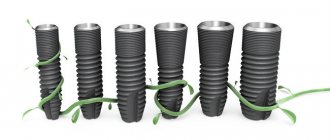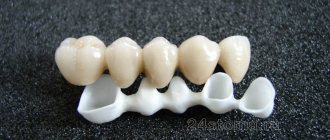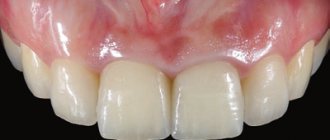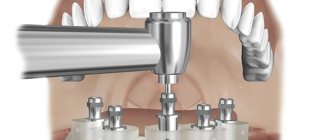Implantation is a technology that allows you to successfully restore teeth in a variety of cases - both when it is necessary to eliminate a single defect in the dentition and when a person is missing all the teeth in the rows. When carrying out implantation, special designs are used - implants implanted into the jaw bone. When the implants take root and completely fuse with the bone, a prosthesis is placed on them.
Implantologists call the moment of installation of a prosthesis on an implant a load, and the loading of implants with a prosthesis can be either immediate or delayed. What is implantation with immediate loading, what are its features, advantages - we will tell you about this in this article. We will find out and consider the indications and contraindications for implantation with immediate loading and provide approximate prices for the service in Moscow.
Calculate the cost of treatment by taking a short test in 20 seconds!
Do not delay your treatment, because in this matter time plays against us.
What is immediate loading implantation?
Implantation with immediate loading is an implantation whose protocol will involve the installation of a prosthesis on the implants almost immediately after their implantation. Usually - two to three hours after installing titanium rods in the jaw bone, sometimes - 2-3 days after surgery. Since the installation of implants and their immediate loading with a prosthesis are carried out in one stage, such implantation is often called one-stage implantation.
WORTH KNOWING AND REMEMBERING: Single-stage implantation is often confused with one-stage technology for installing implants. The difference is that, although simultaneous implantation also uses immediate loading of the implants with a prosthesis, it involves installing implants immediately after tooth extraction, directly into the hole remaining after extraction (removal) of the tooth from the jaw.
During implantation with immediate loading, temporary plastic prostheses are placed on the implants. A person will use them until the implants fully and efficiently fuse with the natural tissue of the jaw. After the osseointegration process of the implants is completed, the temporary prosthesis is replaced with a permanent crown.
Immediate loading with a prosthesis is also used when it is necessary to eliminate a single defect in the dentition and, if necessary, urgently restore all teeth at once. The all-on-4, all-on-6 implantation protocols use immediate loading with a prosthesis, which allows you to extremely quickly solve the problem of complete edentia.
Clinical case 3
A 72-year-old patient sought help regarding the unsatisfactory appearance of her smile. She claimed that not only did the appearance of her teeth make her look older, but she also had problems chewing. Personally, she was not an option for any long-term treatment or a complete removable denture as an alternative. With a full smile, the patient exposed no more than 2-3 mm of the clinical crown (photo 10), thus, there was simply no need for additional manipulations to reduce the level of the bone crest.
Photo 10. Clinical case No. 3: a tense smile to determine the degree of gum exposure.
The vertical parameters of the intermaxillary relationship were significantly destroyed, and the anterior teeth did not provide adequate support to the lip tissues (Figure 11).
Photo 11. View of the dentition with a retractor.
Since it was not possible to register adequate parameters of the vertical parameters of occlusion in the initial position, the doctor determined the height of the intermaxillary relationship at rest, and then subtracted 3 mm from it to obtain the required biometric values. The vertical component at rest was determined by analyzing changes in the position of points on the tip of the nose and chin when the patient slowly opened and closed the mouth until the first touch of the lips. After this, the distance between the points was checked with the mouth completely closed. The difference between the height at rest and with the mouth completely closed was 8 mm. Therefore, it was decided to adjust the intermaxillary height to 5 mm and move the teeth slightly anteriorly to provide adequate lip support.
Using photography and additional composite restorations, a new desired position of the teeth in the structure of the future prosthetic design was determined. After this, a provisional prosthesis was made, the position of the teeth in which was subsequently transferred to the final prosthetic restoration. After extraction of teeth and installation of implants (in a straight position in the frontal area and at an angle of 30° in the distal area), multi-unit abutments and temporary caps (Nobel Biocare) were installed on them (photo 12). The prematurely prepared prosthesis was fitted to the temporary copings (photo 13).
Photo 12. Temporary titanium cylinders installed on multi-unit abutments.
Photo 13. Prosthesis prepared for fitting in the oral cavity.
The caps were fixed with the implants in the prosthesis structure using cold-curing plastic (photos 14 – 16).
Photo 14. Fixation of temporary cylinders using cold-curing plastic.
Photo 15. Using dosing syringes to control the supply of cold-curing plastic.
Photo 16. Temporary titanium cylinders fitted to the prosthesis.
Analysis of the temporary structure confirmed that there was no need for deliberate reduction of the bone crest (Figure 17).
Photo 17. View of the prosthesis a week after loading the implants.
The temporary prosthesis operated for 6 months to fully adapt the patient to the external aesthetic appearance and new occlusal relationships. The final prosthetic design consisted of a titanium framework covered with Gradia gingival composite (GC America) and metal-ceramic crowns cemented over a titanium base (Figure 18). The final result of the restoration is visible in photo 19.
Photo 18. View of the final prosthesis one year after the primary intervention.
Photo 19. View of the patient one year after installation of the implants.
Advantages of implantation with immediate loading
The main advantage of implantation with immediate loading is that it allows you to quickly eliminate a defect in the dentition and relieve a person from psychological discomfort and the need to somehow limit oneself in nutrition. This technique is recommended when it is necessary to quickly restore teeth, either completely, or one or more units included in the smile area.
Also among the advantages of implantation with immediate loading:
- Installation of implants and their immediate loading with a prosthesis - these activities are carried out in one operation;
- Reduced invasiveness of implantation for the patient. When implanting with immediate loading, special implants are used that are integral with the abutment. The entire structure is placed into the jaw bone at one time and onto it and given immediate load with a temporary prosthesis. In two-stage implantation, dismountable implants are used: in the first stage, the implant itself is placed, and the incision on the gum is sutured. After the implant has taken root, the gum is cut again, the former and abutment are placed, and only then the prosthesis is installed;
- Immediate load on the prosthesis has a positive effect on the rate of implant healing. Thanks to immediate loading, implants quickly fuse with the jaw bone;
- Since during implantation with immediate loading, surgical manipulations are minimized, the rehabilitation process is faster.
But implantation with immediate loading also has disadvantages. The most important disadvantage of dental implantation with immediate loading is the increased risk of implant rejection, which occurs because the implanted artificial root will almost immediately be subject to strong pressure from the installed prosthesis. If you incorrectly calculate the degree of this pressure when planning implantation with immediate loading and also choose the wrong implants, the implanted titanium rod may not take root, and the process of its rejection will begin. The correct choice of dentistry for treatment will help reduce the risk of implant rejection after implantation with immediate loading.
The well-equipped clinic has all the necessary equipment that allows you to plan implantation with immediate loading so as to completely eliminate possible risks to the health of patients. The utmost attention is paid to planning and detailed development of implantation in our VENSTOM dentistry in Moscow!
The disadvantages of implantation with immediate loading include a large number of contraindications, which definitely need to be excluded at the stage of preparation for treatment. When is it impossible to perform implantation with immediate loading? We will tell you about this in the next section of our article.
Indications and contraindications for immediate loading dental implantation
Any medical procedure or operation has both indications and contraindications for use. Implantation with immediate loading is no exception in this regard, and if we talk about indications, then this implantation protocol is used:
- 1. If it is necessary to quickly restore all teeth in the jaw (with complete edentia).
- 2. When you urgently need to restore 3-4 missing teeth in a row.
But if you only have one tooth missing, then the doctor will decide on the possibility of implantation with immediate loading on an individual basis.
To achieve excellent primary stability of the implants, which will allow immediate loading of the prosthesis, the structures are implanted into the bone at an angle. If a person has healthy teeth in his mouth next to the defect, then it is not always possible to install an implant in the desired position: the risks of damage to the root part of healthy teeth are too high. Therefore, implantation with immediate loading in the absence of only 1 tooth is rarely performed. The possibility of carrying it out and applying immediate load to the implants with a temporary crown will be determined by the doctor after a diagnosis, including a CT scan of the jaw.
There are many more contraindications to implantation with immediate loading than indications. Let's look at situations in which it is impossible to install implants with immediate loading:
- 1. Implantation with immediate loading requires good bone tissue. To put an immediate load on the implant, it is necessary to obtain its excellent primary stability in the bone, which is unattainable if the bone tissue is loose and does not have sufficient height and volume. If bone deficiency is observed in the upper jaw, then zygomatic implants can be used for immediate loading implantation, thereby eliminating the need for preliminary bone grafting. But if the lower jaw bone has atrophied, implantation with immediate loading is not carried out.
- 2. Implantation with immediate loading cannot be carried out even if the tooth was removed inaccurately and this led to damage to the jaw bone or the formation of a socket that was too wide.
- 3. For oncological diseases, pathologies that cause destruction of bone tissue, disorders of blood clotting processes.
All these contraindications must be excluded at the very first stages of treatment, and for this it is important to carry out a thorough and thorough diagnosis! In our dental clinic in Moscow VENSTOM, implantation is planned based on accurate diagnostics carried out using modern equipment!
How is immediate loading implantation performed?
Treatment begins with a visit to the dental clinic and consultation with an implantologist. At a consultation appointment, the implantologist conducts an examination and prescribes a series of diagnostic examinations that will determine the patient’s general health and see the condition of the jaw bone tissue.
Based on the diagnostic data, the implantation technique is selected (for example, in case of complete edentia, the “all on four” protocol is used) and the implants themselves, which will be installed in the bone. A detailed plan for the upcoming implantation is drawn up, after which preparations for the installation of implants begin.
Before installing implants into the bone, it is important to treat all teeth affected by caries, and also be sure to undergo a professional oral hygiene procedure.
WORTH LEARNING AND REMEMBERING: Why is it so important that high-quality sanitation of the oral cavity is carried out before installing implants? It's simple: plaque and tartar are the most pleasant environment for the development and reproduction of bacteria. If these bacteria get to the implant, an inflammatory process will begin, due to which the titanium rod may be rejected.
The operation itself to install implants with immediate loading goes like this:
- 1. The area where the implants are installed is numbed. Local anesthetics are usually used for this purpose.
- 2. The implantologist creates access to the jaw bone (this is done by puncture) and forms a depression in it, into which the implant with an abutment is inserted.
- 3. A temporary crown is attached to the implant abutment.
There is a break in the treatment process until the implant is completely osseointegrated. When the osseointegration process is complete, the temporary prosthesis on the implant is replaced with a permanent crown. On average, the stage of permanent prosthetics after implantation with immediate loading is carried out after 3-5 months.
Discussion
After comprehensive diagnosis and treatment planning, all patients in the three clinical cases described above were literally able to return to their usual way of life after the first iatrogenic intervention, which eliminated the advisability of using complete removable dentures as the main alternative, and also significantly shortened the duration of the treatment itself. The concept of All-on-Four implantation with immediate subsequent loading of intraosseous titanium elements with provisional prostheses helped to maximize the comfort of the treatment process and minimize the term of subsequent social adaptation of patients. The predictability of immediate loading of implants using the All-on-Four protocol is well documented in the literature, with construct survival rates exceeding 90% (99.3% in the maxilla and 100% in the mandible).
Which is better: implantation with immediate loading or classic implantation with delayed loading?
It is incorrect to answer such a question in absentia, because the implantation technique and the type of load on the implants are always chosen individually for each patient. Therefore, this question can only be answered after visiting the clinic and conducting diagnostics, which will show the condition of the bone tissue and allow you to choose the optimal implantation technique for you.
For patients with a completely toothless jaw, implantation with immediate loading (in the absence of absolute contraindications) will be one of the most cost-effective options for restoring dentition. It will be carried out using “all on four” or “all on six” technologies, which imply the use of a minimum number of implants - hence significant savings, because the more implants are used in dental restoration, the more expensive the implantation is for the patient.
Is the immediate loading implantation technique right for you? Come to our dentistry in Moscow - VENSTOM - and our specialists will answer in detail any of your questions regarding dental implantation!
Calculate the cost of treatment by taking a short test in 20 seconds!
Do not delay your treatment, because in this matter time plays against us.
Cost of implantation with immediate loading
Since implantation with immediate loading is a one-stage implantation that involves fewer manipulations, it will have a lower cost compared to classical dental implantation. However, the exact price of implantation with immediate loading can only be found out in the clinic and here’s why:
- You need to decide on the implantation technique;
- Select implants;
- Consider the cost of preparatory procedures and temporary prosthesis.
And if you are interested in the price of turnkey implantation, then you need to take into account in the total cost the price of a permanent prosthesis, which can be made from different materials and using different technologies. Therefore, to determine your possible costs for dental implantation, the best thing to do is come to the clinic and ask the implantologist to create an individual treatment plan for you!
Advantages of the one-stage implantation method
One-stage dental implantation is widely in demand among patients due to the following positive aspects:
- Eliminates the possibility of additional examination before performing surgery;
- Possibility of performing the procedure in just one visit to the doctor;
- Minimum number of surgical interventions;
- Low degree of trauma, since there is no need to make an incision of soft tissues and suturing them;
- Providing comfortable conditions for the patient with the ability to maintain working capacity;
- Minimal need for the use of anesthetics;
- Reducing the adaptation period to a temporary prosthesis;
- Maintaining chewing functions;
- Possibility of improving aesthetic characteristics in the shortest possible time;
- Eliminates the possibility of facial swelling after the procedure;
- One-stage dental implantation has an affordable price, as does a two-stage technique;
- The survival rate of dental implants exceeds 97%;
- Long operational period of installed structures.
